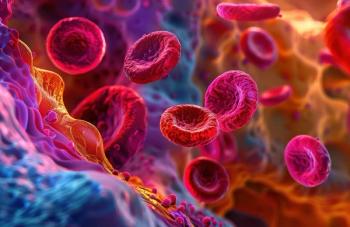
Papakostas Gives Update on Adding Therapy in Treatment-Resistant Depression
With so many options for treatment-resistant depression, expert George Papakostas, MD, said all things being equal, the patient's preference counts.
If a patient with major depressive disorder (MDD) fails to respond to therapy, what comes next? The answer is more complex than it once was, because the list of treatment choices is growing, according to George I. Papakostas, MD, the scientific director for Massachusetts General Hospital Clinical Trials Network and Institute and an associate professor of psychiatry at Harvard Medical School.
Papakostas, who has won many awards for his work on the placebo effect, offered an update on Treatment-Resistant MDD, or TRD, on September 18, 2017, at the US Psychiatric and Mental Health Congress in New Orleans, Louisiana.
“Oftentimes, after treating a patient with antidepressant, we’re going to have to follow up with a number of strategies in order to get them to full remission,” he said, sharing results of a study he led that showed the response rate was 53.4% for antidepressants, compared with 36.6% for placebo.1 “If you look at the placebo effect, it’s not negligible. This isn’t the field of oncology. This is the field of psychiatry.”
The placebo effect can be frustrating but also a powerful lesson that good care comes from a combination of the right therapy and the right people. “The exciting part is, in the clinic, this is a huge advantage,” he said. “Beyond whatever treatments we use and our knowledge of these treatments, our ability to inspire patients to get better, to instill confidence in them, to feel cared for, is a huge therapeutic ingredient.”
Still, it’s essential to know that when a patient cannot achieve remission, he said, a key decision today is whether to switch therapy or to continue a current therapy while adding an adjunctive therapy—either augmenting the antidepressant or using 2 in combination. Both routes have benefits and drawbacks, but “There’s more and more evidence for augmentation,” he said. The question becomes, “Can we do the same job while minimizing these multi-drug risks?”
Papakostas said when he sees a patient with TRD, he goes through a 5-part test:
- Has the patient received the right amount of treatment for the right amount to time? What therapy structured, or was the patient “just sort of attending?”
- Is the diagnosis appropriate?
- Are there comorbidities that have gone unaddressed?
- Are there medication adherence or tolerability issues that have interfered with the success of the regimen?
- Are there pharmacokinetic factors in play, such as the patient being a rapid metabolizer of the drug?
When it comes to adherence, Papakostas is careful not to judge: the vast majority of patients who don’t take medication simply forget, he said, adding, “I don’t think I’ve ever been able to complete an antibiotic regimen with 100% compliance.”
Switching vs Adjunctive Therapy
Switching patients to a different therapy if the first one doesn’t bring remission is no longer automatic, but there are many considerations. The advantages of switching are: limiting the risk of drug interactions, eliminating adverse effects if a therapy wasn’t working, and limiting cost if the patient is already taking other drugs for medical issues. Adding too many drugs can complicate adherence, Papakostas said. But if a therapy had some benefits—just not enough—it may not be wise to risk withdrawal.
Here, he said, the physician faces a dilemma: Should I complicate the regimen, or simplify the regimen? Over the past 15 years, there’s been more evidence for augmentation, and he presented a host of studies for different therapies, including some experimental ones.
Switching. A meta-analysis Papakostas led compared patients with MDD who switched within the class of selective serotonin reuptake inhibitors (SSRIs) with those who switched from SSRIs to a drug outside the class; 23.5% achieved remission switching within the SSRI class, compared with 28% who switched outside the class.2 “That’s not negligible, but the second SSRI can’t be ruled out a reasonable option,” he said.
What if a patient fails 2 SSRIs? “No one has done that study, but I think at that point we can infer it’s best to switch outside the class,” Papakostas said.
Augmentation. Atypical antipsychotics have been studied the most, offering more than twice the remission benefit than placebo (47% vs 22%) for TRD across a meta-analysis that Papakostas and co-authors published in 2007.3 “That was impressive at the time, because most of these patients had failed 2 or more treatments,” he said.
The downside here is that tolerability varies greatly by agent, including some agents that have significant neuroendocrine and metabolic effects. “The early signal confirmed our suspicions that this seemed to work but not every patient would be able to tolerate it,” he said.
Lithium is also well-studied as an augmentation agent, but there are few studies with newer agents, and the positive studies are all of short duration. Lithium also requires blood monitoring.
Papakostas has some experience with the mirtazapine-mianserin combination, which may help with insomnia as it has a sedative effect, but can cause weight gain. Omega-3 fatty acids have been the subject of several studies, are well tolerated, and appear to offer cardiovascular benefits as well, he said.
In the Pipeline
Ketamine. “Soon the ketamine drugs will probably overtake the atypicals,” Papkostas said at one point, acknowledging the excitement over this potential fast-acting treatment. Intravenous ketamine, however, has its limitations, he said.
While several interventions have been studied, Papakostas said the one closest to approval involves an intranasal esketamine augmentation in TRD. He shared pooled results of Phase 1 and 2 studies that were first presented at the American Society of Clinical Pharmacology meeting in 2015, which showed improvements in Montgomery Asberg Depression Scale (MADRS) scores as doses increased. “The higher the dose, the greater the response,” he said.
ALKS 5461. Papakostas explained the mechanism of action of this combination of samidorphan and buprenorphine from Alkermes, which he said made complete sense to him when he first heard about it.
With samidorphan, a mu opioid antagonist, and buprenorphine, a mu agonist and kappa agonist, the result is a kappa opioid receptor antagonist. Why would this work as an augmentation, Papakostas asked?
When people take an opioid, he said, it blocks the pain, and there may be a little bit of a high, but a number of people complain of a dysphoric reaction. Anyone who has taken an opioid after surgery and felt groggy and irritable will understand the effect, he said. But, “What if you block the endogenous opioid receptor agonist from getting to the kappa receptor by blocking the kappa receptor?”
With positive results from phase 2 and phase 3 studies now available, he said, “This is now sitting on FDA’s table.”
With so many choices, how do physicians decide what to use? Decisions between doctors and patients are complex, Papakostas said. “Safety is obviously paramount,” along with tolerability, he said.
Patient history and choice play large roles, too. “All things being equal, I always prefer to go with a patient’s strong choice when we get to a decision point.”
References
1. Papakostas GI, Fava M. Does the probability of receiving placebo influence clinical trial outcome? A meta-regression of double-blind, randomized trials in MDD. Eur Neuropsychopharmacol. 2009; 19(1):34-40. doi: 10.1016/j.euroneuro.2008.08.009.
2. Papakostas GI, Fava M, Thase ME. Treatment of SSRI-resistant depression: a meta-analysis comparing within- versus across-class switches. Biol Psychiatry. 2008; 63(7):699-704.
3. Papakostas GI, Shelton RC, Smith J, Fava M. Augmentation of antidepressants with atypical antipsychotic medications for treatment-resistant major depressive disorder: a meta-analysis. J Clin Psychiatry. 2007; 68(6):826-831.
Newsletter
Stay ahead of policy, cost, and value—subscribe to AJMC for expert insights at the intersection of clinical care and health economics.












































